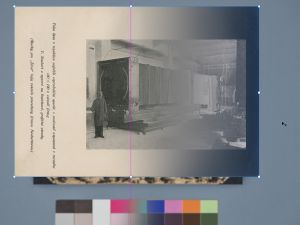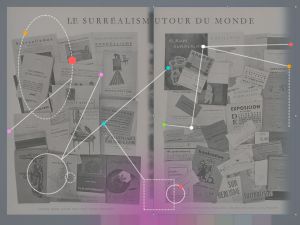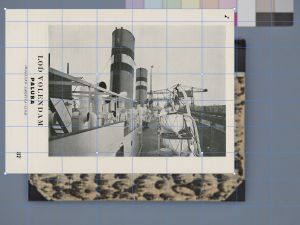The Matrix of Photomechanical Reproductions: Histories of Remote Access to Art
Going back to the advent of photomechanical reproductions of art in periodicals at the beginning of the 20th century, PhotoMatrix examines the far-reaching consequences of this media revolution on the distribution and popularization of art among both experts and the general public.

i
Advertisement for the printer Václav Neubert, Život 2, 1922, p. 213. Photo © Martin Netočný, Institute of Art History of the Czech Academy of Sciences.
While the invention of photography had since 1839 enabled unprecedented access to art for both art historians and the bourgeois public – through diapositives, postcards and albums featuring photo reproductions of artworks – the development of halftone printing at the beginning of the 20th century pushed the mass distribution of art in yet another dimension. Within a few decades, photomechanical reproductions of art had become omnipresent on the pages of illustrated magazines. The way people experienced art and wrote its history underwent substantial changes, which Walter Benjamin famously conceptualized as the loss of aura. The phenomenon is well known, yet few researchers have examined it in connection with photomechanical reproductions of art appearing in the periodical press.
The project focuses on art and art historical periodicals published in Czechoslovakia, Germany, France, and Russia from 1900 to 1950. The reproductions featured in these periodicals are examined quantitatively using the methods of digital art history and qualitatively through archival sources (publishers, photo agencies, photographers, printers, etc.). What new narratives of art emerge if we look at this period through the lens of reproductions printed in contemporary art magazines? What was their impact on the distribution and popularization of art? Through this historical inquiry, the project will open new insights into the remote access to art in the digital age.
Because of its proximity with the Latin mater (mother) and materia (material), the matrix metaphor best describes the operativity of the photomechanical reproduction as a place in which art is conceived and developed. The methodology mirrors both the materiality of the matrices used in the printing industry and the abstractness that characterizes the matrices used for studying various phenomena in science.
The project is organized into three research areas, covering the conditions of production, circulation, and consumption of photomechanical reproductions of art printed in periodicals.
Project Research Areas
Networks and Power Structures

At the turn of the 20th century, photo agencies, commercial picture libraries and printing companies (Giraudon, Adolphe Braun, Alinari, Goupil, Bruckmann, Neubert a synové, Jan Štenc, Agence Diffusion Presse, Hanfstaengl, Jacques Ernest Bulloz, Ottmar Zieher, Stengel & Co., Brogi etc.) began flooding the European market with thousands of images. The research retraces the international chain producing images for European art magazines, uncovering the transnational networks that allowed images to be created, distributed, used, re-used, and circulated in the picture market. Die Kunst für alle, a German magazine founded by Bruckmann – which was also one of the leading companies publishing photographs of artworks – might serve as an example, as well as Umění, published and printed by the Prague-based Štenc graphic company. With the focus on the technological background, economies of exchange, and the strategies of networking, the aim is to uncover how the power structures in the field evolved and for what reasons (price, accessibility, prestige, friendship, aesthetic choices, technological equipment, international reputation, or some other as-yet-unknown aspects).
Circulation of Artistic Models

i
Author unknown, “Le surréalisme autour du monde”, Minotaure, no. 10, 1937, p. 62–63. Photo © Martin Netočný, Institute of Art History of the Czech Academy of Sciences.
With the rise of photomechanical reproduction and the internationalization of the contemporary art scene at the beginning of the 20th century, art journals became one of the primary vehicles for transnational artistic exchange. Leading titles published by the key players of the art world (Volné směry, Cahiers d’art, La Gazette des Beaux-Arts, Sovetskoe Iskusstvo) and progressive avant-garde magazines (ReD, L’Esprit nouveau, Novyi Lef) engaged in a quest for legitimacy and visibility, which often extended beyond national borders. What role did the periodicals’ illustrations play in this regard? This research area assesses the potential of reproductions as a means of strengthening or challenging artistic approaches and theories and spreading them internationally. It examines the strategies that led editors, art critics, and artists to select, exchange, circulate, and stage a given image and the networks that enabled their activity. What trajectories did these images follow? Which images circulated the most, and why? To what extent did they impact the engagement of local artists with foreign artistic approaches?
Social Life of Photomechanical Reproductions

i
Author unknown, “Volendam Boat”, Život 2, 1922, p. 37. Photo © Martin Netočný, Institute of Art History of the Czech Academy of Sciences.
The boom in illustrated magazines allowed the broad public to access reproduced art. Despite a few cautious reactions, most commentators saw it as an instrument for democratization and even a means of social change. The aim is to build on a discussion of the benefits and perils of photomechanical reproductions of art throughout the first half of the 20th century and to identify how the production of these images was affected by their reception. Computational data analysis will provide answers to questions regarding number and size (full-bleed vs. number of smaller photos on one page), their relation to the text, proportion of black-and-white and colour reproductions, zooming in and out (photographic details), and elemental questions concerning the image content (landscape/portrait/still life, old/contemporary art, etc.). In addition, the second life of these images will be investigated, either as clipped art reproductions in the archives of artists, art historians, and art dealers (e.g. the archive of Emil Filla at the Institute of Art History of the CAS) or as “spin-off” products, such as postcards, calendars and industrial objects.